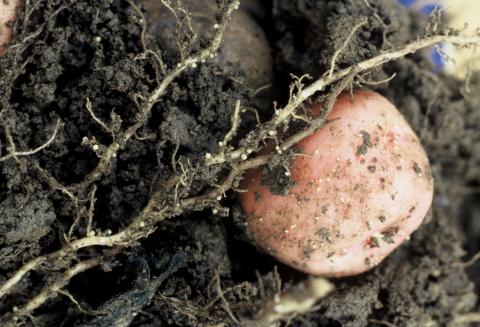Scientists at BioSS have worked with the James Hutton Institute, Science & Advice for Scottish Agriculture (SASA) and the University of Strathclyde to develop a mathematical model to predict how increased temperatures under climate change might influence PCN populations in the future. Two species of PCN are present in Scotland; Globodera rostochiensis (the golden cyst nematode) and Globodera pallida (the white cyst nematode). Recent estimates based on statutory testing carried out by SASA suggest that whilst the area of land infested with G. rostochiensis is relatively stable, the land area infested with G. pallida is currently doubling approximately every 7 years, resulting in an estimated loss of £25m in 2019, which could rise to £125m per year by 2040 without action.
It is believed that this increase in G. pallida but not G. rostochiensis is due at least in part to the fact that approximately 50% of potatoes planted in Scotland are resistant to G. Rostochiensis, while less than 3% are resistant to G. pallida. This increase in G. pallida infestation is particularly concerning because regulations in place to control the damage caused by PCN prohibit the growing of seed potatoes on land which has been found to contain PCN. If the current rate of increase were to continue then it may not be possible to grow potatoes on PCN-free land in Scotland in as little at 30 years’ time.
By developing a stage-structured mathematical model scientists at BioSS found that while warmer temperatures were predicted to accelerate increases in PCN infestation levels, growing potato varieties with even moderate levels of resistance to G. pallida would remain an effective control strategy. Therefore, it is suggested that encouraging increased uptake of resistant varieties by growers, principally through identifying and developing end markets for these varieties, is important to help protect the Scottish seed potato industry.

